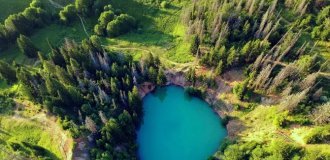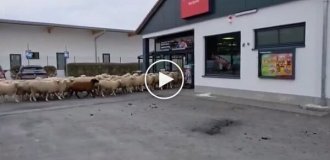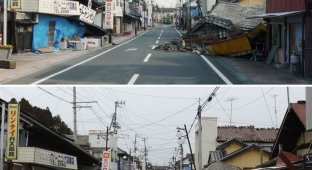How homeless people live in city dumps in the winter (36 photos)
Belarusian journalist Vasily Semashko decided to conduct an extreme experiment to understand how homeless people living outside the city in landfills survive. Having chosen another frosty winter day, Vasily went to the homeless people who live in the city dump near Minsk. He spent day and night with them to understand whether he himself could survive in these inhuman conditions.
Height above sea level - 302 meters
Officially, the city landfill, rising as a majestic mountain north of Minsk, is called the Severny waste landfill. Once upon a time there was a lowland left over from a quarry. The Severny test site was opened in 1981.

“Severny” became the first household waste landfill in the vicinity of Minsk, prepared taking into account environmental safety requirements. To prevent groundwater contamination, the bottom of the quarry was covered with a layer of clay, then covered with a waterproof film.
The initial service life of the landfill was 25 years. That is, it should have been closed more than 10 years ago. The next closure of the landfill is now scheduled for 2018.
The height of the waste heap from the ground level is 85 meters - a height of approximately 28 floors. For comparison, the Mound of Glory is only 30 meters high. The height of “Severny” above sea level is 302 meters, despite the fact that the highest point in Belarus, Mount Dzerzhinskaya, is 345 meters. The waste heap is one of the ten highest places in Belarus.

Solid municipal waste is brought here from the northern part of the city for disposal. Every day, 500–800 trucks deliver 8,000 cubic meters of waste. Previously, along the serpentine, trucks climbed to the very top, increasing its height. Now garbage trucks empty containers on the site adjacent to the main waste heap. I climb up a steep, sandy, sometimes snow-covered slope. Step up - the leg slides down half a step. The working part of the landfill is visible from above.

Waste collected for purchase is stored in construction bags.

Among the garbage trucks and bulldozers, a minibus is visible, probably from a buyer of recyclables. He clearly has no right to be here, just like the homeless, but if we think humanly, the homeless, together with the buyer, are doing the hard and useful work of sorting garbage. Bulldozers from the Chelyabinsk plant level and compact garbage.

Once the debris layer reaches 2 meters, it is covered with a 20-centimeter layer of sand. Often, for this purpose, molding soil from a foundry is used, which is subject to burial. This “layer cake” accelerates the decomposition of waste and prevents fires from spreading deeper. A huge flock of crows periodically takes off from the area of fresh garbage and, after making a circle, returns to its place.

The waste heap surrounds the ditch, into which the filtrate seeps out - a poisonous, foul-smelling, oil-like liquid that freezes only in the most severe frosts - a squeeze from the garbage.
As garbage rots, it produces “landfill gas,” which consists of 50% methane. In 2013, as part of a Belarusian-Swiss project, a 5.6 MW power plant was launched at Severny, generating electricity from landfill gas. Methane enters the power plant furnace through pipes that are laid in a waste heap in drilled wells. It is planned that after the closure of the landfill, the waste will rot for at least 20 years, releasing flammable gas.

Formally, the waste site is guarded, and unauthorized persons should not be here. In reality, only the entrance to the testing site is protected - all cars arriving here are registered. A private owner who wants to get rid of garbage will have to pay an entry fee at the checkpoint. At the same time, the security guards are not interested in homeless-looking people passing by.
Like any city landfill, people come here to sort the garbage, selecting waste that can be returned for money - primarily non-ferrous metals (copper, aluminum), cullet, and waste paper. Some of these people have housing in Minsk or surrounding villages, and some are classic homeless people.
From the height of the waste heap on a frosty evening there is a wonderful view into the distance.

On the horizon, the chimneys of the Minsk thermal power plants smoke, supplying the city with heat, the lights come on, and the flagpole near the new presidential residence flashes like a beacon.

The last garbage trucks for today continue to arrive at the landfill, delivering waste from the big city, giving the local homeless people the opportunity to survive. As dusk sets in, homeless people can be seen walking along the paths into a small waste forest near the waste heap. Most of them are carrying construction waste bags filled with something.

By the time I climbed down the steep slope of the waste heap and reached the forest along the path, it got dark.
Inhabitants of Buda: two women, two men and a cat
In the forest, near the edge, a shed was built with walls made of linoleum and pieces of plastic film. Through a hole in the wall under the ceiling one can see that there is a fire burning there and voices can be heard. The entrance is covered with a blanket.
I ask permission to enter. Allowed. There are 8 people in the shed around the fire. It’s heavily smoky—it’s impossible to stand upright for long because of the smoke—it stings your eyes. I introduce myself and tell them that I want to make an article about how “free people” survive in such cold weather.
The answer, if translated into literary language, is that they survive well. And then the question: “Is there vodka?” There was vodka.
They invite you to the fire.
I pass on a bottle and a snack - brisket, bread and several packages of Rollton.
“I might as well not have brought food, especially Rollton—we have plenty of food.”
Let's get acquainted. The head of the company is Sergei. He is the only one of the whole brethren who is shaven. The barn is called a buda. Sergey, Andrey and their friends Katya and Irina live in Buda. Now they are visiting two colleagues from neighboring Buda, located a couple of hundred meters away.

From previous journalistic communications with homeless people, I know that rarely do any of them immediately admit that they have no housing - they come up with the idea that supposedly everyone has housing, but they only came here to work. Therefore, I’m not asking you to tell the story of “how I became homeless” - the topic of surviving in winter is more interesting.
- My buda is considered good. I am a former builder. What's it like here? Those who haven’t built a normal one in the summer will find it difficult in the winter,” explains Sergei.
Budas are sheds for living. All building materials are from landfill. Buda is a frame made of boards. It is upholstered with oilcloths, pieces of polyethylene, and insulated with carpets and blankets. Some budas may have stoves like potbelly stoves, but Sergei does not have a stove. Buda Sergei - three rooms. In two you can stand at full height. The first is a living room with a fireplace. The second is a type of storage room. There is a bucket of frozen feces in it. The third room with a ceiling height of only 1.5 meters is the bedroom. The bedroom is filled with mattresses, blankets, and bedspreads.
“Don’t be afraid, we don’t have lice,” reassures Sergei, “we are constantly monitoring this.” If we find anything with lice, we burn it immediately. As for scabies, we don’t have it.
Smoke from the fire comes out through a hole in the wall. Plastic food packaging burned in a fire gives the smoke a particularly pungent quality. To have something to breathe, you have to open the door slightly. The warmth of the fire is felt only close: two meters from the fire the temperature is below -10 °C.
They drown with fragments of window frames and wooden pallets brought from the landfill in bags.
With his relatively neat appearance and lack of a beard, Sergei stands out among other homeless people.
The rest have faces stained by fire with very obvious signs of alcohol abuse.
Living with the homeless in Buda is their favorite, the playful teenage cat Masha.

After drinking just a little vodka, the women became drunk - a sign of alcoholism.
Katya is 56 years old. Specialty: mosaic tiler. She lived nearby in a village and had been coming to the landfill since its inception, collecting food waste for her pigs.

Irina will be 50 years old this year. She says that she worked as a teacher in a kindergarten. They live in the landfill for about 10 years.
Andrey turned out to be my age - 44 years old. He said that he was from the Vitebsk region and was a military man.

Sergei is 50 years old. Builder. From Minsk.
One of the guests who basked in Buda is considered a veteran. Of his 44 years, he lived constantly at the landfill for 26.

“I can’t look at bananas and pineapples.”
“Remember,” Sergei explains, “don’t call the landfill a dump.” This is not accepted. We call it the shaft. There's enough room for everyone here. We are engaged in waste sorting. You can hand it over to the landfill collection point nearby and receive money, or private owners come directly to the shaft to collect waste. They transport waste to collection points in Minsk, where they pay twice the price, and make a big profit on this - cars are changed often.
Indeed, I saw at the gate of the landfill how someone who arrived in a new Ford Transit demanded that some homeless person work off his debt. He nodded his head, promising to do it tomorrow.






















